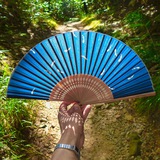Momiji season has almost ended but famous sightseeing spots are still swarming with people wearing traditional costumes and using Go To Travel campaign coupons in souvenir shops. It's been one month since I came back to Japan but I still haven't found a permanent place to stay and keep moving from one hotel to another exploiting the domestic travel subsidy program that covers 35 percent of the original accommodation cost and gives another 30 percent of what you actually paid in coupons which can be exchanged for goods in most shops and restaurants. Considering the high initial fees of renting a long-term apartment (they can go up to 2-3 times of the monthly rent) the hotel option works better for me now since I haven't decided on my research plan and its geography yet. Coronavirus taught me how to be an obedient nomad — cumulatively it's already my third month living in Japanese hotels in 2020.
I found this place by chance last year when me and my friend from Tokyo wanted to grab some coffee after visiting Shisen-do temple, another popular momiji spot in northern Kyoto. From the outside you can only see a flower shop - a dried flower shop, to be precise, but it's just the ground floor. As soon as you enter, an intense smell of wild summer grass hits you, and little vintage trinkets displayed on the glass shelves evoke a warm nostalgic feeling. So the shop itself is quite impressive, but if you take the narrow stairs up, you'll get immersed into even more scents and flowers, and strange scandinavian ambient/folkish music. When these eerie sounds get suddenly interrupted by the sound of a coffee machine hidden behind the heaps of herbal decorations, you'll realize this is a coffeeshop and notice a few couples enjoying their drinks and whispering in between the flowers. Definitely the most interesting interior I've seen in Kyoto so far.
Custom bamboo covers for traffic cones protecting front porch of the building from bikes and cars. Aren’t they adorable? #onlyinkyoto kind of thing.
After living in Kyoto for more than one year I finally realized I need to confirm something that has been raising doubts in my head every time I walk past Gion district. What's the difference between geisha and geiko? And who is maiko? A friendly bartender explained: "geiko" is just a Kyoto-way of saying "geisha". And maiko are geisha's students, both in Kyoto and elsewhere. However, it's not easy to tell which one is which from just their appearance. Here's a short instruction, now try guessing who I captured in these photos.
